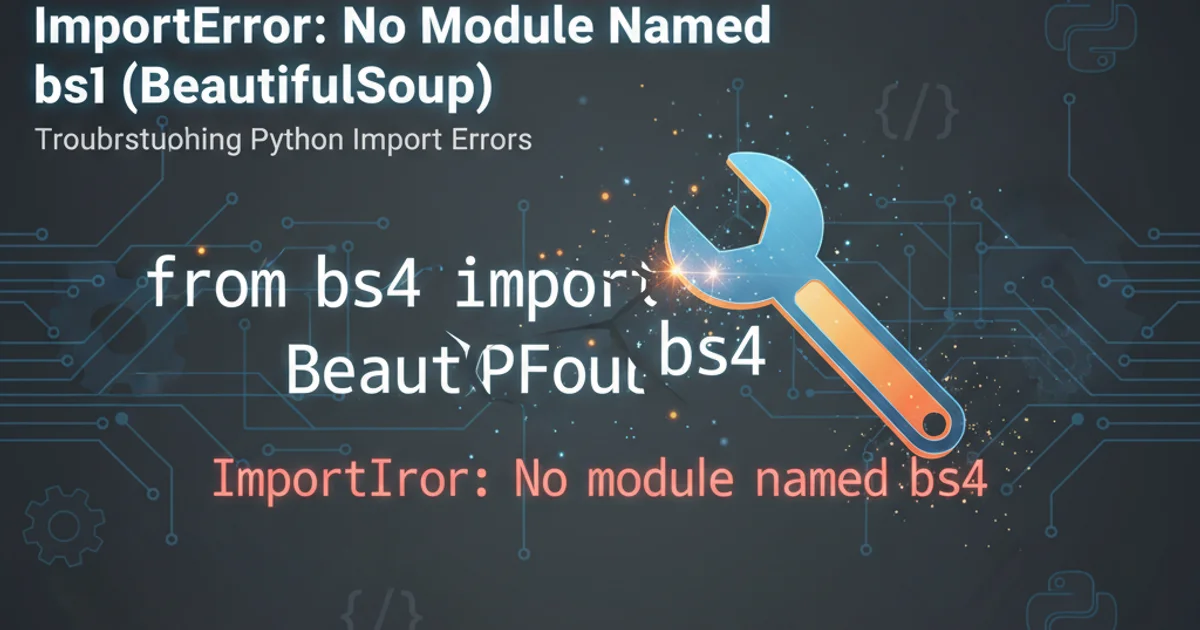ImportError: No Module Named bs4 (BeautifulSoup)
Categories:
Resolving 'ImportError: No Module Named bs4' for BeautifulSoup

This article guides you through troubleshooting and fixing the common 'ImportError: No Module Named bs4' when working with BeautifulSoup in Python, covering installation, environment issues, and common pitfalls.
The ImportError: No Module Named bs4 is a frequently encountered issue for Python developers attempting to use the BeautifulSoup library for web scraping. This error indicates that the Python interpreter cannot find the bs4 module, which is the core component of BeautifulSoup. This guide will walk you through the common causes and provide clear, actionable solutions to get your web scraping projects back on track.
Understanding the 'No Module Named bs4' Error
When Python executes an import statement, it searches for the specified module within a list of directories defined in sys.path. If the module is not found in any of these locations, an ImportError is raised. For bs4, this typically means one of two things:
- BeautifulSoup is not installed: The most common reason is that the library hasn't been installed in your current Python environment.
- Incorrect environment or path: You might have multiple Python installations or virtual environments, and BeautifulSoup was installed in a different one than the one you're currently using.
flowchart TD
A[Start Python Script] --> B{Import bs4?}
B -->|Yes| C{Is bs4 in sys.path?}
C -->|Yes| D[Module Found - Success]
C -->|No| E[ImportError: No Module Named bs4]
B -->|No| F[Continue Script (No bs4 Needed)]Flowchart illustrating the Python module import process and potential failure point for 'bs4'.
Solution 1: Installing BeautifulSoup
The primary solution is to ensure BeautifulSoup is correctly installed. The library is typically installed using pip, Python's package installer. BeautifulSoup 4 (BS4) is the current version, and its package name is beautifulsoup4.
pip install beautifulsoup4
Command to install BeautifulSoup 4 using pip.
pip3 instead of pip if you have both Python 2 and Python 3 installed, to ensure you're installing for the correct Python 3 environment: pip3 install beautifulsoup4.Solution 2: Verifying Installation and Environment
Even after installation, the error can persist if you're using a different Python environment or if the installation path isn't correctly configured. Here's how to verify:
1. Check Python Version
Open your terminal or command prompt and run python --version or python3 --version to confirm which Python interpreter is active.
2. Check pip Version
Run pip --version or pip3 --version. This will show which Python interpreter pip is associated with. Ensure it matches the Python version you intend to use.
3. List Installed Packages
Use pip list or pip3 list to see all packages installed in the current environment. Look for beautifulsoup4 in the list. If it's there, check its version.
4. Test Import in Python Interpreter
Open a Python interpreter by typing python or python3 in your terminal. Then, try from bs4 import BeautifulSoup. If this works, the issue might be with how your script is being run.
import sys
print(sys.path)
# After successful installation, try this:
from bs4 import BeautifulSoup
print("BeautifulSoup imported successfully!")
Python code to inspect sys.path and test the import.
bs4.py or beautifulsoup.py as this can create a circular import or cause Python to try importing your own file instead of the installed library.Solution 3: Using Virtual Environments
Virtual environments are highly recommended for Python development. They isolate project dependencies, preventing conflicts between different projects. If you're not using one, this is a good opportunity to start.
1. Create a Virtual Environment
Navigate to your project directory and run python3 -m venv venv (or python -m venv venv on some systems). This creates a folder named venv containing the isolated environment.
2. Activate the Virtual Environment
On macOS/Linux: source venv/bin/activate. On Windows: .\venv\Scripts\activate.
3. Install BeautifulSoup in the Virtual Environment
With the virtual environment active, run pip install beautifulsoup4. This ensures BeautifulSoup is installed specifically for this project.
4. Run Your Script
Execute your Python script. The ImportError should now be resolved.
(venv) your_user@your_machine).